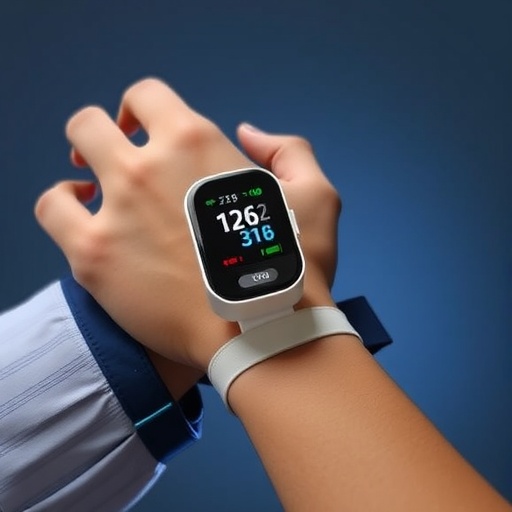In a groundbreaking development for health technology, researchers at Seoul National University have unveiled an innovative wearable device poised to transform the landscape of blood pressure monitoring. Led by Professor Seung Hwan Ko, the research team from the Wearable Soft Electronics Lab has pioneered a device that adheres comfortably to the skin, functioning much like a bandage, allowing for real-time and continuous monitoring of blood pressure over extended periods.
This revolutionary device diverges from traditional methods, which typically rely on cumbersome cuff-based blood pressure monitors that inflate to exert pressure on the arm. Instead, this state-of-the-art solution employs a compact and flexible electronic patch. The unique design has not only garnered significant interest but represents a substantial step forward in making blood pressure monitoring more accessible and less intrusive.
The urgency surrounding effective blood pressure management cannot be overstated. Out of approximately 1.3 billion individuals suffering from hypertension worldwide, a staggering 79% struggle with adequate management of their condition. The limitations of conventional cuff-based devices are manifold; they only provide one-time measurements, which poses challenges for continuous monitoring. Furthermore, the discomfort associated with the cuffs often discourages patients from using these devices consistently, thus diminishing their effectiveness. This heightened need underscores the importance of a solution like the one developed by this research team.
The primary breakthrough of the new wearable device stems from the analysis of the time delay between two types of signals generated by the heart: electrical signals captured via electrocardiograms (ECGs) and the mechanical signals of the pulse. This time difference is cleverly correlated with blood pressure levels. When blood pressure is elevated, the speed of blood flow increases, thereby shortening the time gap between the two signals. In contrast, a drop in blood pressure results in a longer time interval between these signals. By brilliantly leveraging this physiological principle, the research team has developed a model that accurately tracks both systolic and diastolic blood pressure through precise detection of these signals with every heartbeat.
Detecting subtle shifts in skin movement as blood flows can be exceptionally challenging. Recognizing this, the researchers designed the device to naturally adhere to the skin using a newly engineered substance known as liquid metal. This material remains pliable at room temperature and exhibits excellent conductivity, making it an ideal choice for the electronic circuitry required in this groundbreaking device.
However, working with liquid metal presents its own set of challenges. The material is plagued by exceptionally high surface tension, complicating the process of forming precise circuits. To overcome this limitation, the research team implemented a technique dubbed “laser sintering.” Through this innovative method, finely dispersed liquid metal particles are selectively heated with a laser, allowing them to fuse precisely where needed. This approach not only streamlines the creation of circuit patterns but also retains the necessary flexibility of the device.
In testing the device, the researchers demonstrated remarkable mechanical and electrical performance. The electronic patch maintained its efficacy even when stretched to 700% of its original size or when subjected to over 10,000 cycles of repeated stretching. Furthermore, the device displayed its ability to detect rapid fluctuations in blood pressure surrounding physical exertion, offering superior monitoring capabilities compared to existing cuff methods.
The implications of this technology are vast. By simply attaching the device to the wrist, real-time monitoring of blood pressure becomes feasible, freeing patients from the inconvenience of periodic hospital visits or the static nature of traditional blood pressure measurements. For individuals managing chronic conditions like hypertension, the device promises to deliver vital, continuous insights into their health status anytime and anywhere.
Moreover, the device’s capability to monitor blood pressure fluctuations during exercise opens up exciting possibilities for tailored fitness programs and personalized therapy prescriptions. The technology also holds promise for integration into an array of wearable devices, such as smartwatches and advanced medical patches. Ultimately, this innovation is expected to be instrumental in heralding a new era of healthcare, one where proactive disease prevention and health management seamlessly integrate into daily life.
According to Professor Seung Hwan Ko, the research epitomizes a paradigm shift in blood pressure measurement, challenging the long-held notion that such evaluations are both inconvenient and limited to occasional checks. He envisions this system as a new interface for healthcare that can noninvasively capture and analyze physiological signals in real time, reshaping the standard patient experience.
The co-first authors of the study, Jung Jae Park and Sangwoo Hong, are already setting their sights on future research endeavors, aiming to enhance the technology’s practicality and expand its integration potential. The team intends to explore adding various substrate materials and incorporating wireless communication capabilities alongside AI-driven data analysis.
This latest advancement from Seoul National University holds great promise, not just in terms of improving individual health outcomes, but also for its potential applications in intensive care monitoring, workplace health, and lifestyle analytics. As the world increasingly embraces personalized healthcare solutions, this wearable device stands out as a beacon of innovation that might soon define the way we approach blood pressure management and overall health monitoring.
Subject of Research: Blood pressure monitoring technology
Article Title: Highly Sensitive Cuffless Blood Pressure Monitoring with Selective Laser-Sintered Liquid Metal Conductors
News Publication Date: Date pending publication
Web References: [Link to article, if applicable]
References: [Citations for study, if applicable]
Image Credits: © Advanced Functional Materials
Keywords
wearable technology, blood pressure monitoring, hypertension, liquid metal, health innovation, continuous monitoring, electrocardiogram, smart healthcare, laser sintering, biomedical engineering, personalized health management.




